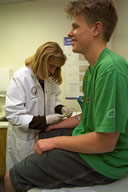CDC Support for the Emergency Management Assistance Compact (EMAC)
This information is for historic and reference purposes only. Content has not been updated since the last reviewed date at the bottom of this page.
For current EMAC information, please visit https://www.emacweb.orgexternal icon
Ratified by Congress and signed into law in 1996, the Emergency Management Assistance Compact (EMAC)external icon is an interstate mutual aid agreement that provides a mechanism for sharing personnel, equipment and resources among states during emergencies and disasters. EMAC has traditionally been used by states for National Guard, emergency management and other types of response assistance. More recently, it has been used to provide public health and medical assistance with much success. Some benefits of using EMAC include
- Increased collaboration among states during emergency preparedness, response and recovery;

- Better awareness and understanding of state and local needs;
- Increased access to personnel, equipment and resources;
- Consideration of legal issues related to worker compensation, liability, credentialing and reimbursement.
All 50 states, three territories (U.S. Virgin Islands, Puerto Rico and Guam), and the District of Columbia have enacted legislation to become members of EMAC. To use EMAC in the most effective manner possible, health departments are encouraged to collaborate with their emergency management agencies and other response partners to increase their awareness and understanding of the EMAC system, organization, components and principles. Health departments are also encouraged to participate in education and training on EMAC whenever possible.

The Centers for Disease Control and Prevention (CDC) facilitates and supports efforts to provide education, awareness and training on EMAC to local, state and federal public health professionals.
Related Resources
- Official website for the Emergency Management Assistance Compact (EMAC)external icon
- Emergency Management Assistance Compact (EMAC) Preparedness Guide and Deployment Tips for State, Local Tribal Public Health and Medical Personnelexternal icon
- EMAC: A Model for Regional Coordinationexternal icon
Office of the Assistant Secretary for Preparedness and Response (ASPR), U.S. Department of Health and Human Services (HHS) - A Menu of Suggested Provisions for Public Health Mutual Aid Agreements
- GAO Report: Emergency Management Assistance Compactexternal icon
Enhancing EMAC’s Collaborative and Administrative Capacity Should Improve National Disaster Response - CDC Public Health Law Program Mutual Aid Web Site
- CRS Report for Congress – The Emergency Management Assistance Compact (EMAC): An Overview
Lindsay, Bruce R., Congressional Research Service, July 21, 2008pdf iconexternal icon (160 KB/10 pages)